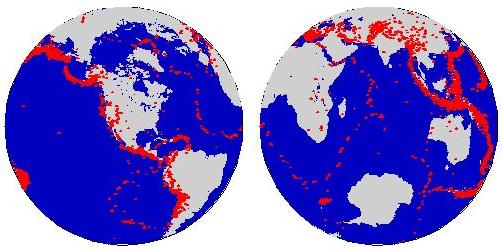
That's how the American Geological Institute Glossary of Geology defines one. Most earthquakes occur along faults, or breaks, in the Earth's crust. The San Andreas fault in California is the one that we're all familiar with, but there are millions of faults all over the earth, including many right here in New Mexico. The largest faults occur along the edges of the huge tectonic plates that comprise the Earth's crust, and move slowly about, grinding against each other. Energy is stored up as the plates push against each other, and then is suddenly released as an earthquake when the strength of the Earth is exceeded. Try slowly bending a plastic ruler or twig with one hand while you hold it firmly with the other. If you let go, there will be a sudden release of stored energy, just as in an earthquake. The point on the Earth's surface directly above the point at which the sudden release takes place is known as the epicenter, and seismic waves radiate outwards from the epicenter much like the waves that spread when a pebble is dropped into a calm pond. A great deal of our knowledge about the interior of the Earth comes from the study of seismic waves as they move through the Earth. The map below, produced by Dr. Richard Aster (while at New Mexico Tech), shows the locations or epicenters of earthquakes that occurred throughout the world in 1992, which clearly trace the plate boundaries.  Maybe you're thinking that we're safe and sound here in New Mexico, hundreds of miles from the nearest plate boundary. Well, that would be a big mistake! Earthquakes can also be generated along much smaller faults, including many right here in New Mexico.
Maybe you're thinking that we're safe and sound here in New Mexico, hundreds of miles from the nearest plate boundary. Well, that would be a big mistake! Earthquakes can also be generated along much smaller faults, including many right here in New Mexico.
Although the tremendous force of tectonic plates grinding against each other is responsible for many earthquakes, we humans can cause them as well. For example, nuclear bomb explosions produce small earthquakes and one of the ways in which nuclear test bans are verified is to monitor earthquake activity in different parts of the world. The impoundment of large surface water reservoirs such as Lake Mead, or Heron an El Vado reservoirs in New Mexico, is known to cause earthquakes because the large volume of water exerts pressure on the Earth. Removing fluids from or injecting them into the Earth can also cause earthquakes, such as those near the Denver Arsenal in the 1960s and some earthquakes in southeastern New Mexico. These are known as induced earthquakes, and Colorado attorney Darlene Cypser has a web site devoted completely to them.
Created by Bill Haneberg
Cartoons by Jan Thomas
last modified: 25 April, 2022